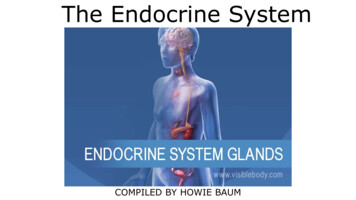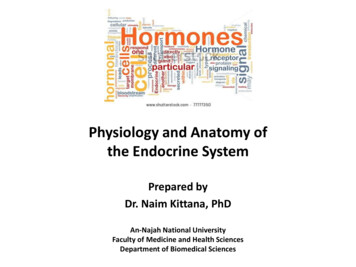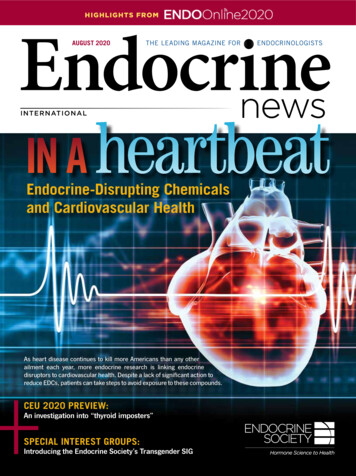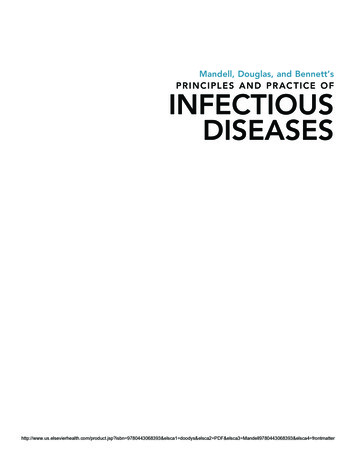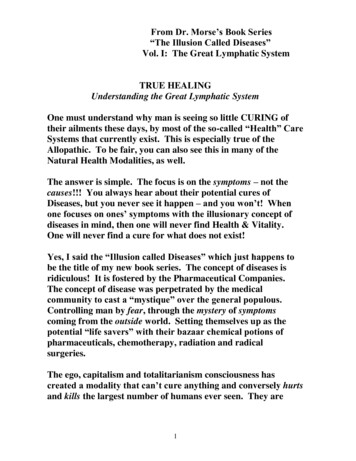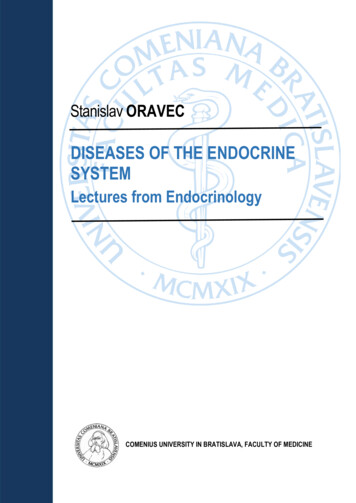
Transcription
Stanislav ORAVECDISEASES OF THE ENDOCRINESYSTEMLectures from EndocrinologyCOMENIUS UNIVERSITY IN BRATISLAVA, FACULTY OF MEDICINE
DISEASES OF THE ENDOCRINE SYSTEMLectures from Endocrinology Stanislav Oravec, MD, PhD.Professor of Internal MedicineComenius University in Bratislava, Faculty of Medicine, 2018ScriptumUniversity teaching text Stanislav Oravec, MD, PhD.Comenius University in Bratislava, Faculty of Medicine, 2018No. of pages: 69; 3,70 AH.1st edition. Published online.Reviewer:prof. Ing. Zdeňka Ďuračková, PhD.ISBN 978-80-223-4581-1
PrefaceThis book comprises teaching texts for those students and young physicians beginning to studyendocrinology. It is an overview of the most important endocrine diseases, it helps to learn thecorrect endocrine diagnostics and offers an effective treatment of endocrine diseases. I wish itwould be a principal aid in basic medicine study for students of medicine, but also a conciseendocrinology guide for physicians who exert a medical practice.A profound thought of Doctor Francis W. Peabody from the year 1927:“The essence of the practice of medicine is that it is an intensely personal matter the treatmentof a disease may be entirely impersonal; the care of a patient must be entirely personal. Thesignificance of the intimate personal relationship between physician and patient cannot be toostrongly emphasized, for in an extraordinarily large number of cases both diagnosis andtreatment are directly dependent on it One of the essential qualities of the clinician is interestin humanity, for the secret of the care of the patient is in caring for the patient”, is timely untilnow and should serve as additional guidance.Stanislav Oravec, MD, PhDProfessor of Internal MedicineMedical faculty of Comenius Universityin Bratislava
ContentIntroduction6Endocrine diseases – basic terms and definitions6The endocrine systemEndocrinologyHormones – active moleculesEndocrine pathologyThe sites of the principal endocrine glands66667Hypothalamus and hypothalamic hormonesPituitary gland and pituitary hormonesThyroid glandParathyroid glandsAdrenal glandPancreasTestisOvaryGastrointestinal hormonesHypothalamic hormones – physiological functionPituitary hormones – physiological functionAnterior pituitaryPosterior pituitary7777777888888The principal endocrine axes of glands regulation9Axis hypothalamus – pituitary – peripheral glandHypothalamo-pituitary axisAnterior pituitary trophins – peripheral glandsTSH – ThyroidACTH – Adrenal cortexLH, FSH – OvariesLH, FSH – TestesPRL – Mammary glandGH – Growth Hormone – SkelettHormones of hypothalamus – posterior pituitaryAdiuretin – Kidney – Distal nephronOxytocin – Uterus – Mammary glandDiseases of the hypothalamus – pituitary systemA Diseases of the hypothalamus – ClassificationA.1 Hypothalamus hormone excess syndromePubertas praecoxCushing s disease (Morbus Cushing)A.2. Hypothalamus deficiency syndrome – Hypopituitarism –Hypothalamic hypopituitarismKallmann s syndromeFröhlich syndrome911111111111111111212121212121213131313
Prader-Willi syndromeLaurence-Moon-Biedl syndromeAnorexia nervosaDiabetes insipidus centralisB Diseases of the pituitary – ClassificationB.1 Anterior pituitary hormone excess – Anterior hyperpituitarismProlactinomaAcromegalyCentral Cushing s syndrome (Cushing s disease, Morbus Cushing)Rare tumours of TSH-, LH-, and FSH-omasB.2 Pituitary hormone deficiency syndromes – Anterior hypopituitarismAnterior pituitary – HypopituitarismGrowth hormone (GH) deficiencyGonadotrophin (LH, FSH) deficiencyAdrenocorticotrophin (ACTH) deficiencyThyreotrophin (TSH) deficiencyCauses of hypopituitarismPosterior pituitaryDiabetes insipidusC Hormone resistance – Laron syndrome – defects in the GH receptorD Non functioning tumoursPituitary adenomaMetastatic tumoursCraniopharyngiomaThyroid diseaseHyperthyroidismClinical features of hyperthyroidismGraves Basedow diseaseToxic adenomaToxic multinodular goitreHyperthyroid crisisHypothyroidismPrimary hypothyroidismClassification of primary hypothyroidismSecondary hypothyroidismMyxoedema comaSimple goitreSimple diffuse goitreSimple multinodular goitreThyroiditisAcute thyroiditisSubacute thyroiditisChronic lymphoid thyroiditis – Hashimoto s thyroiditisRiedel s thyroiditisMalignant tumours of thyroidPapillary carcinomaFollicular carcinomaAnaplastic carcinoma and lymphomaMedullary 1414244
Multiple endocrine neoplasia (MEN) syndromesMEN I (Werner s syndrome)MEN II (Sipple s syndrome)Parathyroid gland diseasesMajor manifestations of diseases of the parathyroid glandsHypercalcaemia, HypocalcaemiaPrimary hyperparathyroidismSecondary hyperparathyroidismTertiary hyperparathyroidismAdrenal diseasesAdrenal cortexAdrenal medullaClassification of Cushing s syndromeCushing s syndrome – hypercorticismCushing s diseaseEctopic ACTH syndrome – paraneoplastic Cushing s syndromeAdrenal adenoma (Peripheral form of Cushing s syndrome)Adrenal insufficiencyAddison s diseaseAdrenal crisis – Addisonian crisisPrimary hyperaldosteronism and mineralocorticoid excess –– Conn s syndromeSecondary hyperaldosteronismDiseases of adrenal medulla – excess of catecholamines secretionPhaeochromocytomaAcute situations in endocrinologyHyperthyroid crisisMyxoedema comaAdrenal crisis in Addison s disease (Addisonian crisis)Hypercalcaemia and hypercalcaemic etic ketoacidosis in diagnosis of diabetesComplications of diabetic ketoacidosisNon-ketotic hyperosmolar diabetic comaLactic 1525353555556575759595960616263646568686869
IntroductionEndocrine diseases – basic terms and definitionsThe endocrine system co-ordinates the body s internal physiology, regulates its developmentthroughout life, and helps it to adapt to nutrition and other external environmental changes.The system is based on a number of glands, which secrete hormones into internal medium toact on target tissues.Hormones first interact with specific high-affinity receptors in the cells, or on the cells oftarget tissues.Receptor activation then initiates a cascade of linked biochemical reactions within the cells,that produce the specific response.Endocrinology concerns the synthesis, secretion and action of hormones. Hormonesrepresent chemical messengers - diverse molecular structures (proteins, peptides, steroids) are released from endocrine glands - coordinate the activities of many different cells.Endocrine diseases – heterogeneous group – wide range of manifestations affecting manyother organs.Hormones – active moleculesHormones are biologically high active drugs of the body which control the metabolic activityall different tissues and organs in the body. They play an important role in development andgrowth of the body, they control the reproduction mechanisms, they help how to adapt oneveryday life-stress and how to survive.Hormones can be classified according to chemical composition, solubility properties, thelocation of receptors, or the nature of the signal used to mediate their action within the cell.Peptides (e.g. Insulin), polypeptides and proteinsGlycoproteins (thyroid stimulating hormone, TSH)Steroids (adrenal cortex hormones, sex hormones – androgens, estrogens, gestagens)Amines (e.g. Noradrenalin, Adrenalin) act on:– specific cell surface receptors / through G-proteins & enzymes on the cytosolic side ofthe plasma membrane/,– specific intracellular receptors / bind to response elements on DNA to regulate genetranscription (steroid hormones, thyroid hormones, Vitamin D).Endocrine pathologyPathology arising within the gland is called a primary disease (e.g. primary hypothyroidism in Hashimoto s thyroiditis)Abnormal stimulation of the gland from pituitary secondary disease (e.g. secondaryhypothyroidism (in patients with pituitary tumour and TSH deficiency).Some endocrine diseases are common:Thyroid gland disease (occurs in 10% population in areas with iodine deficiency)Reproductive system diseasesΒ-cells of the pancreas – Diabetes mellitus (DM) Type 1Many rare endocrine syndroms – particular – are a diagnostic challenge to primary care(i.e. phosphor metabolism abnormalities)6
The sites of the principal endocrine glandsHypothalamus & Hypothalamic hormonesIn the median eminence the following releasing and inhibiting hormones are synthesized:TRH – thyrotrophin releasing hormone,GnRH – gonadotrophin releasing hormone,CRH – corticotrophin releasing hormone,GHRH – growth hormone releasing hormone,Somatostatin (somatostatin releasing inhibiting hormone SRIH), /peptide/,PIF – prolactin inhibiting factor (dopamine) /biogenic amine/.Pituitary gland & Pituitary hormonesAnterior pituitary:TSH – thyroid stimulating hormone thyrotrophin /glycoprotein/,LH – luteinizing hormone,FSH – follicle-stimulating hormone,GH – growth hormone,Pre-pro-opiomelanocortin [ACTH, β-lipotrophin, α-melanocyte-stimulating hormone(MSH), corticotropinlike intermediate lobe peptide - endogenous opioids – endorphins,enkephalins, (CLIP)],ACTH – adrenocorticotropic hormone,PRL – prolactin /proteins/.Posterior pituitary:oxytocin, vasopressin (ADH) adiuretin arginine vasopressin (AVP) /peptides/.Thyroid gland:T4, T3 – thyroxine and triiodothyronine /tyrosin derivatives/.Parathyroid glands:(four): parathyroid hormone /peptide/.Adrenal gland: (two glands, left and right adrenal gland):Adrenal cortex: aldosterone,cortisol /steroids/,androgens,esterogens /steroids/.Adrenal medulla: epinephrine (adrenaline),norepinephrine (noradrenaline),opamine /catecholamines/.Pancreas (islets of Langerhans):insulin, glucagon, somatostatin /proteins/.Testis (two) testes:testosterone,5α dihydrotestosterone /steroids/.Ovary (two) ovaries:oestogens,progesteron,androgens /steroids/.7
Gastrointestinal hormonessynthesized in stomach (gastrin) /peptides/,duodenum and jejunum (secretin, cholecystokinin) /proteins/.Hypothalamic hormones - physiological function* TRH: thyrotrophin-releasing hormone thyroliberin – releases TSH and PRL* LH FSH-RH GnRH: gonadotrophin releasing hormone gonadoliberin – secretion ofLH, FSH* Dopamine – Prolactin inhibiting factor: - inhibits PRL secretion – (breast lactation)* GHRH: growth hormone releasing hormone somatoliberin - GH - IGF-I, IGF-II –insulinlike growth factors (body growth)* Somatostatin: inhibits GH secretion* CRH: Corticotropin releasing hormone – ACTH cortisol secretion in adrenal cortex* Oxytocin – uterus, breast (parturition, lactation)* Adiuretin (ADH) distal nephron (water balance)Pituitary hormones – physiological functionPituitary control of the function of the peripheral glands - most endocrine glands arecontrolled by hormones released from the pituitary (gland).Anterior pituitary (adenohypophysis) hormone secretion is controlled by substancesproduced in hypothalamus and released into portal blood circulation. Anterior pituitaryhormones trophins are controlled by hypothalamic releasing/ or inhibiting hormones.Posterior pituitary hormones are synthesized in the hypothalamus(nucleus supraopticus, nucleus paraventricularis) – transported down nerve axons to bereleased from the posterior pituitary (neurohypophysis)Anterior pituitary - The hypophysiotrophic hormones – trophins regulate the function ofperipheral endocrine glandsTSH – thyroid stimulating hormone: thyroid growth, hormone secretion of thyroid: T4,T3LH – luteinizing hormone- female: ovulation, corpus luteum, progesterone synthesis- male: testosterone synthesis, dihydro-testosterone synthesisFSH – follicle stimulating hormone- female: growth of follicles, oestrogens synthesis- male: interstitial cells - spermatogenesis, secretion of inhibin –- feedback of spermiogenesis controlACTH – adrenocorticotropic hormone (pre-pro-opiomelanocortin)growth of adrenal cortex, cortisol synthesis(MSH, also a functional part of ACTH) melanocyte stimulating hormone – controlsmelatonin synthesis in the skin (after UV- light exposition)GH – growth hormone: growth stimulation through IGF-I (insulin like growth factor-I) somatomedin C (IGF-I is synthesized in the liver)PRL – prolactin: lactation, growth of breast in pregnancy, inhibits LH and FSH secretionPosterior pituitaryOxytocin: contraction of smooth muscles in uterus during labour (parturition)In myoepithelial cells in the duct of mammary gland (lactation)8
Adiuretin - (antidiuretic hormone) - also called vasopressin: water excretion in distalnephron (water balance) is a potent vasoconstrictor.Hormone release (in the hypothalamus and pituitary) is regulated by numerous stimuli ofnervous metabolic, physical hormonal origin, in particular feedback control by hormonesproduced by the target glands (thyroid, adrenal cortex and gonads). These integratedendocrine systems are called axes:The principal endocrine 'axes' and glandsAxis hypothalamus – pituitary – peripheral gland- thyroid- adrenal cortex- ovaries- testesFigure 1: Anatomical relationships and function of the pituitary and hypothalamusSource (Figures no. 1-3): BOON, N.A., COLLEDGE, N.R., and WALKER, B.R., (eds.).Davidson’s Principles and Practice of Medicine. 20th ed. Philadelphia: ChurchillLivingstone/Elsevier Health Sciences Division, 2006, xvi, 1381 p. ISBN 978-0-443-10057-4.Available at: www.studentconsult.com9
Figure 2Figure 310
Hypothalamo-pituitary axisAnterior pituitary trophins – peripheral glandsThe hypothalamo-pituitary axis plays the central role in the endocrine system.Releasing hormones of hypothalamus anterior pituitary trophins peripheral glandsTSH Thyroidhyperfunctionhypofunctionprimary /secondaryprimary/secondaryMorbus Graves / tumour with TSH Morbus Hashimoto / tumour with TSHACTH Adrenal cortexhyperfunctionhypofunctionprimary /secondaryprimary/secondaryCushing s syndrome / tumour-Morbus Cushing Morbus Addisoni / CRH ACTH Cortisol(empty sella)LH, FSH Ovarieshyperfunctionprimary /secondarytumour-ovary / pituitary tumourhypofunctionprimary/secondaryovarial insufficiencymenstrual dysturbances / infertility,Morbus Sheehan postpartal necrosisLH, FSH Testeshyperfunctionhypofunctionprimary /secondaryprimary/secondarytumour testis / pituitary tumororchiis/ autoimmuneinflammationimpotence: impotentia generadi/ coeundiPRL Mammary glandhyperfunctionhypofunction–/secondary– / secondaryprolactinoma-tumourhypoPRL - inflammationinfertilty, menstrual dysturbances–GH Skellethyperfunctionhypofunction/secondaryprimary/ secondary/ pituitary GH-tumour Laron dwarf, IGF1 / hypopituitary nanismgigantism, GH dwarfacromegaly(epiphyseal fusion)11
Hormones of hypothalamus posterior pituitaryAdiuretin Kidney Distal aneoplastic (tumour) ADH secretion ADH secretion Diabetes insipidus (DI)inappropriate ADH secretionprimary / secondarywater intoxicationNephrogenic DI / Central DIOxytocin Uterus overproduction Mammary glandinsufficient productionduring parturitioninsufficient uterus contractionsDiseases of the hypothalamus – pituitary systemare rare, annual incidence of approx 1: 50 000 subjects.Disorders of the hypothalamus and pituitary may present as endocrine or neurologicdysfunction. I. Hypersecretion (prolactinoma, acromegaly, central Cushing s disease)/hyposecretion (hypopituitarism, adrenal insufficiency, central hypogonadism) of pituitaryhormones, II. neurological manifestations (space occupying lesions, headache, visualdisturbances) - due to pressure effects from tumor or cause abnormal autonomic function.Endocrine manifestations of hypothalamic and pituitary causes are similar. The pituitary playsa central role in several major endocrine axes, so that investigation and treatment involvesseveral other glands.A Diseases of the hypothalamus – ClassificationA.1 Hypothalamus hormone excess syndromeA1.a Pubertas praecoxA1.b Cushing s disease (Morbus Cushing)A.2 Hypothalamus deficiency syndrome – Hypopituitarism – HypothalamichypopituitarismA.2.a Kallmann s syndromeA.2.b Fröhlich syndromeA.2.c Prader-Willi syndromeA.2.d Laurence-Moon-Biedl syndromeA.2.e Anorexia nervosaA.2.f Diabetes insipidus centralisA.1 Hypothalamus hormone excess syndromeA.1.a Pubertas praecox – Precocious puberty– presenting clinical features of hypothalamic disease in children. The presence ofhypothalamic tumours may initiate the early onset of normal mechanisms of pubertalmaturation, with excessive skeletal growth but a reduced ultimate height. Gn-RH: stimulation12
of pituitary secretion of LH, FSH and secretion of testosterone in testes, secretion of estradiol(17 β-E2) in ovaries, hCG- human chorionic gonadotrophin increases steroid synthesis ingonads.A.1.b Cushing s disease – Morbus Cushing - Central Cushing s syndromeCentral hypercortisolismCRH ACTH cortisol in adreno-cortexSee Lecture: Adrenal cortex diseases and Cushing s syndromeA.2 Hypothalamus deficiency syndromes - Hypothalamic hypopituitarismA.2.a Kallmann s syndromeHypothalamic defect of Gn-RH deficiency causes secondary deficiency of pituitarygonadotrophins LH, FSH and consequent hypogonadism (low testosterone secretion in boys,low estrogen secretion in girls).The initial defect can be congenital, which can be associatedwith a reduced sense of smell – anosmia.A.2.b Fröhlich syndrome, Dystrophia adiposogenitalisHypothalamic defect caused by a tumor, inflammation or degenerative changes in hypothalamicarea. Reduced secretion of Gn-RH results in hypogonadism development. Dominant clinicalsigns are obesity in childhood, associated with underdeveloped infantile genitalia as aconsequence of gonadotrophin deficiency. Th.: In case of tumor-neurosurgical extirpation oftumor and Gn-RH substitution therapy.A variant is the syndrome of small genitalia in fat boys. The reduction in genital size is not real,as a penile shaft is buried in the suprapubic fat pad and is normal in size. The testes are alsonormal in size for a prepubertal boy Pseudo dystrophia adiposogenitalis. Th.: Dietaryrecommendations and reduction of body fat.A.2.cPrader-Willi syndrome,A.2.d Laurence-Moon-Biedl syndrome- familial disorders associated with characteristic facies, mental retardation, hypotonia,hyperphagia resulting in severe obesity, disordered diurnal rhythm. Disease manifestation inchildhood. Reduced Gn-RH secretion in hypothalamus results in central hypogonadism withunderdeveloped small genitalia. Laurence-Moon-Biedl syndrome is a central hypogonadismassociated with retinitis pigmentosa, polydactylia and congenital heart defects.A.2.e Anorexia nervosaAnorexia nervosa (AN) is a disorder of unknown ethiology, (mental abnormality) seen in youngwomen under the age of 25 years, particularly common in females adolescents. Disorderpresents as anorexia, severe weight loss, amenorrhea, behavioral changes- hyperactivity andpreoccupation with food. Hypothalamic-pituitary dysfunction. Gn-RH, decreased LH a FSHsecretion, profound E2 deficiency central hypogonadism, euthyroid sick syndromedevelopment. If weight is regained, Gn-RH secretion returns to the adult pattern. Treatment:estrogens replacement is indicated, continued preoccupation with food and persistent dietingbehaviour. Treatment of anorexia nervosa remains a major therapeutic challenge.A.2.f Diabetes insipidus centralisSee lecture Diabetes insipidus in chapter Pituitary insufficiency – Hypopituitarism, ADHDiabetes insipidus page 19-20.13
B Diseases of the pituitary – Classification– two different forms of diseasesB.1 Syndromes of hormone excess:Prolactinoma, Acromegaly, Central Cushing s syndromeB.2 Syndrome of hormone deficiency:Hypopituitarism, Isolated secondary hypogonadism,adrenal insufficiencyspace occupying lesions: headache and/or visualdisturbancesClassification of diseases of the pituitaryB.1 Pituitary hormone excessAnterior pituitary – HyperpituitarismB.1.a ProlactinomaB.1.b AcromegalyB.1.c Central Cushing s diseaseB.1.d Rare TSH-, LH- and FSHomasB.2 Pituitary hormone deficiencyAnterior pituitary – HypopituitarismGrowth hormone deficiencyGonadotrophin (LH, FSH) deficiencyAdrenocorticotrophin (ACTH) deficiencyThyreotrophin (TSH) deficiencyPosterior pituitary – Cranial diabetes insipidusC Hormone resistance – Growth hormone resistance (Laron dwarfism)Diabetes insipidusD Non functioning tumoursPituitary adenomaMetastatic tumoursCraniopharyngiomaB.1 Anterior pituitary hormone excess - Anterior pituitary hyperpituitarismB.1.a ProlactinomaAetiologyElevation of plasma PRL levels – common finding. PRL arises from a variety of causes:Physiological* Stress* Pregnancy* Lactation* Chest wall reflex (e.g. nipple stimulation)* Wet nursing reflex (e.g. baby crying)14
DrugsDopamine antagonists* Antipsychotics (phenothiazines, butyrophenones)* Antidepressants* Antiemetics (e.g. Metoclopramide, domperidone)Dopamine-depleting drugs* Reserpine* alpha Methyldopa* Oestrogens* Oral contraceptive pillsPathologicalCommon* Disconnection hypeprolactinemia (e.g. non-functioning pituitary macroadenoma)* Prolactinoma (usually microadenoma)* Primary hypothyroidism* Polycystic ovarian syndromeUncommon* Hypothalamic disease* Pituitary tumour secreting PRL and GH* Renal failureRare* Post herpes zoster* Ectopic sourceClinical featuresCardinal features. In women: (microadenoma)Galactorrhoea & hypogonadismhypogonadism: oligomenorrhoea or amenorrhoea andmenorrhagiaanovulation with infertilityIn men:decreased libido, erectile impotence, reduced shaving frequency,lethargy, galactorrhoea (macroadenoma)Investigation:PRL more than 500 mU/lDuring pregnancy and lactation 20 000 mU/lStress, drugs, non-pregnant, non-lactating woman 500-1000 mU/lMicroprolactinoma, disconnection hyperprolactinemia: 1000-5 000 mU/lLevels above 1 000 mU/l highly suggestive of prolactinomaMacroprolactinomas 1000 000 mU/lExamination of thyroid function: TSH fT4 - to exclude primary hypothyroidismPRL more than 1000 is an indication for MRI, CT exam. of hypothalamus and pituitaryMRI will detect all macroadenomas and 70% of microadenomas (in 30% normal scan) –the presumptive diagnosis is small microadenoma.ManagementDopamine agonist therapyBromocriptine 2.5mgin treating infertility headache, vomitusCabergoline 0.25 mgunsuitable for treating infertilityQuinagolide 50 ug non-ergotamineuntested in pregnancy15
(Pergolide 5.0 mg old drug bromocriptine-like vomitus, headache)Surgicalmicroadenomas - removed selectively by trans-sphenoidal surgerycure rate about 80%External irradiation to prevent regrowth of tumour residuumB.1.b Acromegalycaused by Growth hormone (GH) secretion from a pituitary tumour, usually amacroadenomaGH hypersecretion- before epiphyseal fusion – gigantismafter fusion in adult life – acromegalyClinical features of acromegaly:Soft tissue changes* Skin thickening* Increased sweating* Headache* Enlargement of lips, nose, tongue* Acromegalic arthropathy* Myopathy* Carpal tunnel syndrome* Visceromegaly (e.g. thyroid, heart, liver)Acral enlargement* Large hands (difficult to remove rings)* Large feet (increasing shoe size)Other bone changes* Growth of lower jaw – prognathism* Skull growth – prominent supraorbital ridges with large sinuses* Kyphosis* OsteoarthritisMetabolic effects* Glucose intolerance (25%)* Diabetes mellitus (10%)* Hypertension (25% associated with increased body sodium)Long-term complications* Atheromatous diseases (two-to threefold relative risk)* Colonic cancer (two- to threefold relative risk)InvestigationsMeasuring GH levels in plasma is neededMeasuring GH levels during an oral GT test.(Interpretation)In normal subjectsGH level is suppressed to below 2 mU/l.In acromegalyGH level is not supressed, in about 50% of patientsparadoxal rise of GH levelHyperglycaemia, glucose intolerance,IGF-1(somatomedin C) , PRL 30% of patients - increased PRL16
X-ray of skeleton and skull - sella turcica,MRI, CT examination of the pituitary fossa should be performedOphthalmological examination– Visual field: Diplopia, strabism: pressure on the 3rd, 4th or 6th cranial nerves.– Visual field defect: bitemporal hemianopia and upper quadrantanopia– compression inoptic chiasm and optic nerveX-ray of chest: heart hypertrophyAdditional tests: screening for colonic neoplasm with colonoscopyManagement - Therapeutic modalitiesSurgicalTrans-sphenoidal surgery – 1st line of treatmentRadiotherapyExternal radiotherapy – second-line of treatment, if acromegaly persists after surgery (tostop tumour growth)MedicalIn patients with persisting acromegaly after surgery to lower GH levels 5 mU/lSomatostatin analogues (e.g. Octreotide Lanreotide i.m. every few weeks)Dopamine agonists less potent, helpful in patients with associated hyper PRLBromocryptine - ParlodelGH receptor antagonists (e.g. Pegvisomant)B.1.c Central Cushing s syndrome(Cushing s disease, Morbus Cushing)CRH ACTH cortisol in adreno-cortexCentral hypercortisolismSee Lecture: Adrenal cortex diseasesCushing s syndromeB.1.d Rare tumours of TSH-, LH-, and FSH-omasExcess of TSH secretion – central hyperthyrodimsB.2 Pituitary hormone deficiency syndromes– Anterior pituitary hypopituitarismdescribes combined deficiency of any of the anterior pituitary hormonesclinical features are highly variable and depends on the underlying lesion.Growth hormone (GH) deficiency – Hypopituitary nanism - congenital defects of thehypothalamus – short statue. In adults GH secretion – the earliest to be lost. Lethargy, muscleweakness increased fat mass in abdomen.Gonadotrophin (LH, FSH) deficiencyIn male: loss of libido, impotence, gynaecomastia, absence of axillary and pubic hairdecreased frequency of shavingIn female: oligomenorrhoea or amenorrhoea, infertility, absence of axillary and pubic hair, thefiner and wrinkled skin.17
Adrenocorticotrophin (ACTH) deficiencyCortisol insufficiency – Central Morbus Addisoni Central Addison s diseaseWith lack of stimulation of melanocytes by β-lipotrophic hormone (MSH) – a fragment of theASTH precursor peptide in the skin – white Morbus AddisoniClinical featuresFatigue, weakness, anorexy, hypotension, hypoglycaemia, normal plasma potassium levels(angiotensin II - dependent zona glomerulosa is not lost – normal aldosterone secretionmaintains normal plasma K !!)Adrenocortical insufficiency often precipitated by mild infection.Untreated severe hypopituitarism results in coma.See lecture: Diseases of adrenal cortex - Adrenal insufficiency, Addisons s disease p. 54Thyreotrophin (TSH) deficiency – secondary hypothyroidismClinical featuresApathy, cold intolerance, Absence of frank myxoedema (in contrast to primaryhypothyroidism), low pulse rate, hypecholesterolemia, atherosclerosis development, coronaryheart disease (CHD) development Low TSH – low thyroid hormones level in blood: T4 T3See Lecture: Thyroid disease – Hypothyroidism, central and peripheral hypothyroidism p.32Causes of aHead injurySurgeryRadiotherapyCongenitalGnRH Kallmann ssyndromePituitaryStructuralPituitary tumourSurgeryRadiotherapyHead injuryLocal meningiomaFunctionalSarcoidosisTBC, SyphilisHistiocytosisEncephalitissecondary tumourpost-partum necrosis(Sheehan s syndrome)autoimmune inflammationhaemorrhage (apoplexy)HaemochromatosisAnorexia nervosaMalnutritionInvestigationsIn acutely unwell patients the priority is to diagnose and treat cortisol deficiencyPlasma cortisol, free cortisol excretion in 24 hours urine.TSH, fT4 fT3,Specific dynamic testsACTH stimulation test 250 ug ACTH (Synacthen) by i.m. Injection at any time of dayBlood samples: 0 and 30 minutes for plasma cortisol0 minutes also for ACTH (on ice)Results: normal plasma cortisol 550 nmol/l at baseline or at 30 minuteslower plasma cortisol - adrenocortical insufficiencyGnRH testTRH testCT or MRI to identify pituitary / hypothalamic tumours.18
ManagementThe treatment of acutely ill patients in adrenocortical insufficiency:Medical emergencyHydrocortisone succinate 100 mg i.v.Intravenous isotonic saline fluid and 10% dextrose, or 5% glucoseParenteral hydrocortisone 100 mg i.m. 6-hourly, until gastrointestinal symptoms abateoral cortisol therapyChronic hormone replacement therapiesCortisol (hydrocortisone) 15 mg and 5 mg at 18,00 hrsThe precise dose adjusted for the individual patients by analysis of free cortisol excretionin 24 hrs urineThyroid hormone replacementThyroxine 0.1 – 0.15 mg once a daily p.o.TSH assay is not helpful T4 and T3 assaySex hormone replacementin premenopausal femalesCyclical oestrogen therapy on days 1-21 and progesterone on days 14-21in post-menopausal females HRT is effective for menopausal symptoms andprevention osteoporotic fractures.Androgen replacement therapy in men: Testosterone implant 600-800 mgsubcutaneously every 3-6 monthsThe adult patients with hypopituitarism feel better and have objective improvements, ifthey are given GH replacement. GH improves quality of life.– Posterior pituitary deficiency syndromeDiabetes insipidusUncommon disease. Diabetes insipidus is characterised by a persistent excretion ofexcessive quantities of diluted urine and by thirst.Diabetes insipidus (DI) is divided into:Cranial diabetes insipidus - deficient production of ADHNephrogenic diabetes insipidus – distal nephrons are unresponsive to ADH (adiuretin)Clinical featuresPolyuria, polydipsia, 5-20 liters or more of urine in 24 hours, with low specific gravityand osmolalityCauses of diabetes insipidus (DI)- CranialHypothalamic or high stalk lesionCraniopharyngioma, head injury, surgery, histiocytosis, sarcoidosis, pituitary tumourwith subprasellar extension, basal meningitis, encephalitisIdiopathicGenetic defectDIDMOAD syndrome DI associated with DM, optic atrophy, deafness- NephrogenicGenetic defectMetabolic abnormality: Hypokalaemia, hypercalcaemiaDrug therapy: lithium, demeclocyclinePoisoning: heavy metals19
InvestigationsElevated plasma osmolality i.e. 300 mOsm/kgnormal 285-295 mOsm/kgADH not measurableOsmolality of urine
endocrinology. It is an overview of the most important endocrine diseases, it helps to learn the correct endocrine diagnostics and offers an effective treatment of endocrine diseases. I wish it would be a principal aid in basic medicine study for students of medicine, but also a concise e


